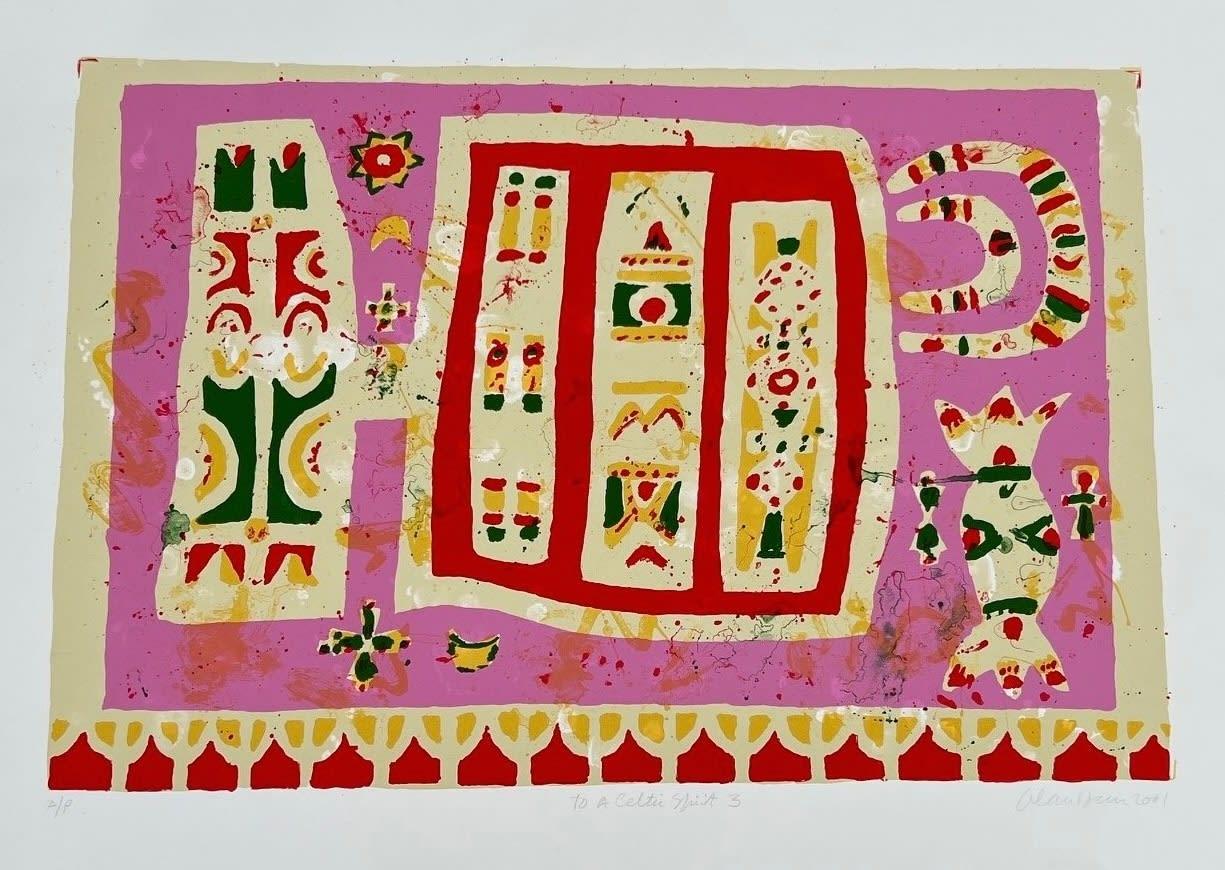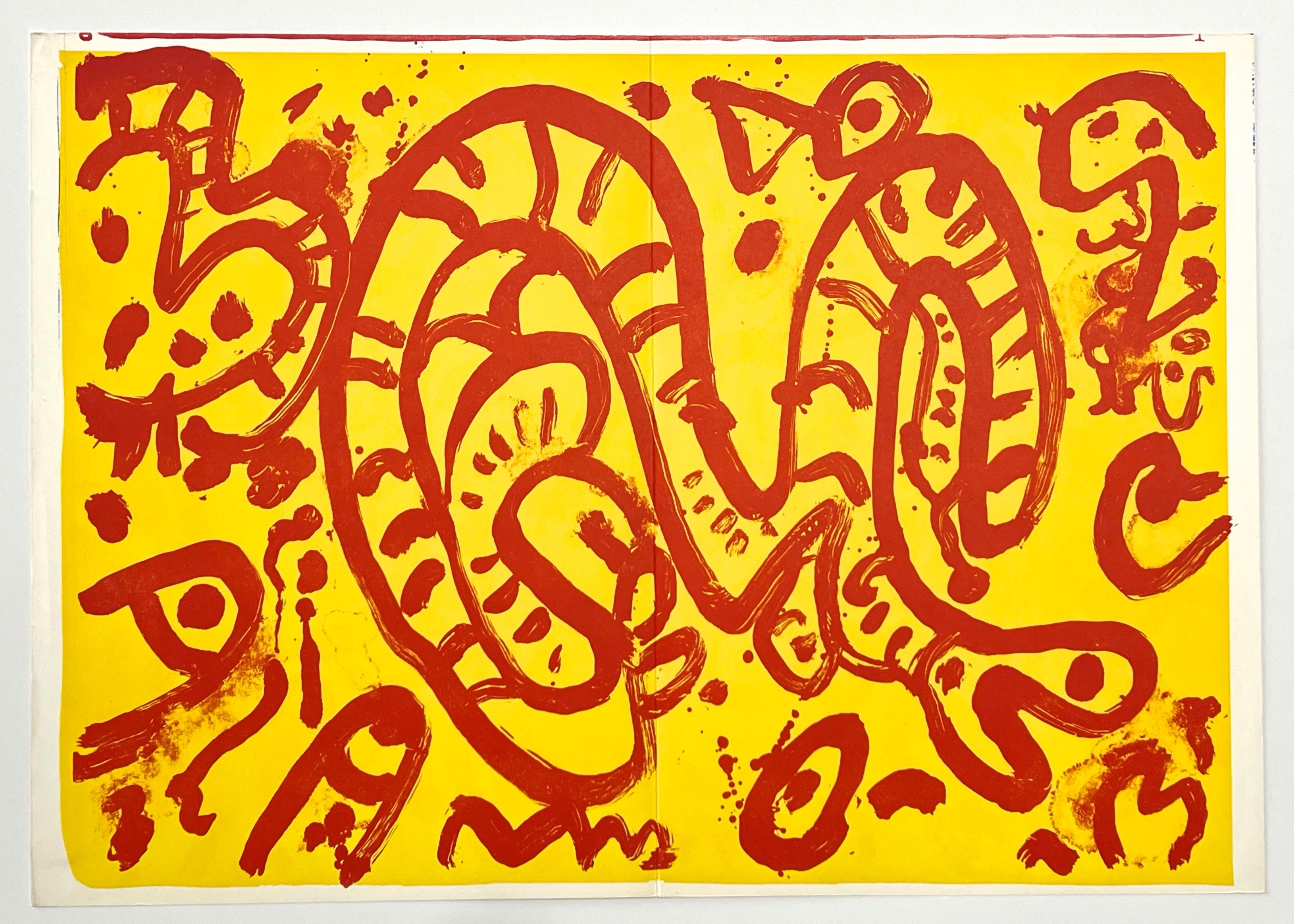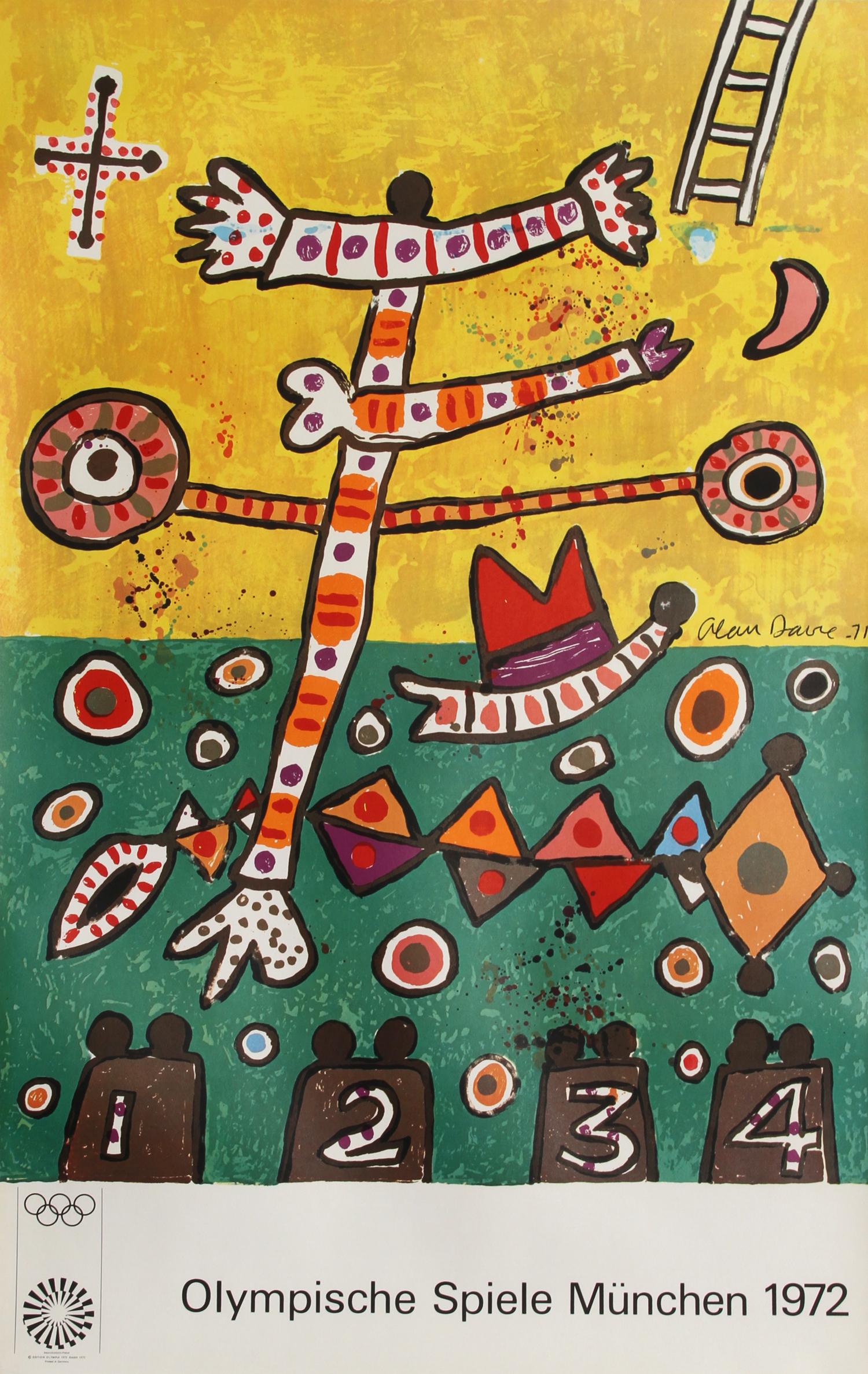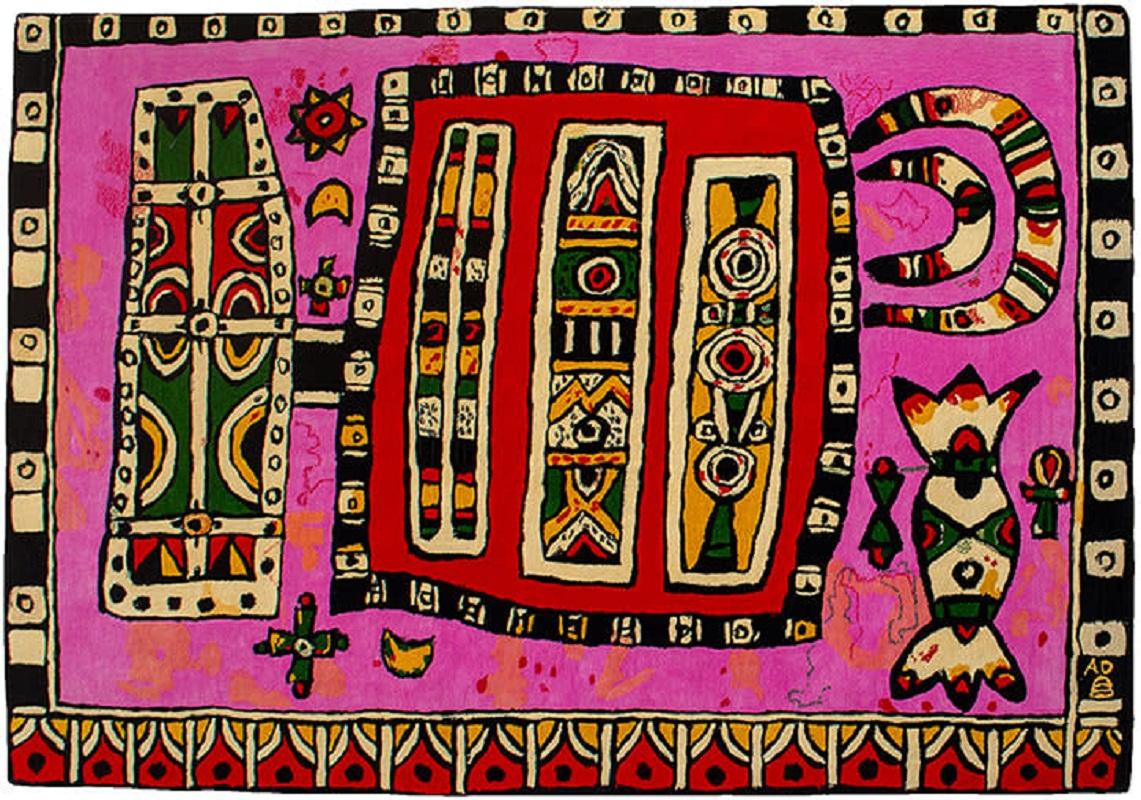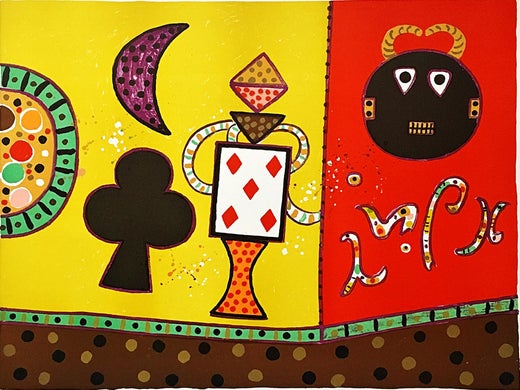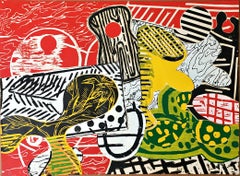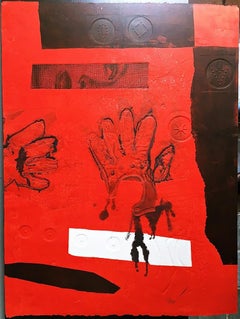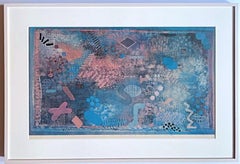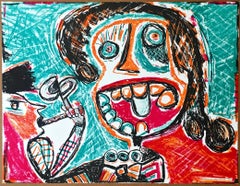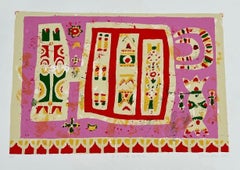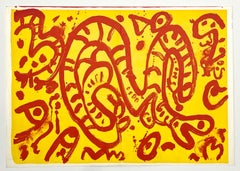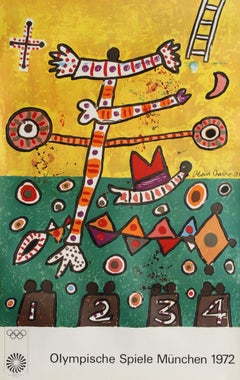Items Similar to Guli Wall rare 1970s lithograph by famed Scottish Pop artist Alan Davie Signed/N
Want more images or videos?
Request additional images or videos from the seller
1 of 8
Alan DavieGuli Wall rare 1970s lithograph by famed Scottish Pop artist Alan Davie Signed/N1971
1971
$1,125
$1,50025% Off
£865.57
£1,154.0925% Off
€989.13
€1,318.8425% Off
CA$1,610.14
CA$2,146.8625% Off
A$1,755.83
A$2,341.1125% Off
CHF 922.38
CHF 1,229.8525% Off
MX$21,044.70
MX$28,059.6025% Off
NOK 11,696.74
NOK 15,595.6625% Off
SEK 10,884.92
SEK 14,513.2325% Off
DKK 7,387.71
DKK 9,850.2925% Off
About the Item
Alan Davie
Guli Wall, 1971
Lithograph on Rives BFK Paper with Deckled Edges
Hand signed, numbered 26/200 and dated on the lower front
20 × 25 1/2 inches
Unframed
This whimsical mid-century modern hand signed, dated and numbered print by renowned Scottish-born British Pop artist Alan Davie published in 1971 was chosen to be included in the 1975 portfolio for the Swiss Society for Fine Arts (Grafikmappe des Schweizerischen Kunstvereins) as part of an international portfolio of 27 prints by world renowned artists including Jasper Johns, Christo, Valerio Adami, Shusaku Arakawa, Robert Cottingham, Richard Paul Lohse, Gerhard Richter, Dieter Roth, Pierre Tal Coat and many others.. Hand signed and numbered from the edition of 200. Unframed and in fine condition. This vintage European print is especially uncommon stateside.
Alan Davie (1920 - 2014) was one of Scotland's most internationally recognised artists with works in public collections across the world. Early on, Davie appreciated the significance of American Abstract Expressionism, having seen Pollock's work in Peggy Guggenheim's collection in Venice in 1948, an experience that inspired him to paint with more improvisation and on a much larger scale. In 1956 Davie made his first trip to the United States where he was the subject of a solo exhibition at the Catherine Viviano Gallery where he was introduced to Robert Motherwell, Jackson Pollock, Franz Kline, Mark Rothko, and Willem de Kooning. By the early 1960s Davie was drawing increasingly on myth and magic symbolism, viewing himself less as an artist than as a medium, or shaman, borrowing signs and symbols from cultures as diverse as the Navajo Indians, the Caribbean islands, Aboriginal Australians, and the Ancient Egyptians, Celts and Picts.
- Creator:Alan Davie (1920, British)
- Creation Year:1971
- Dimensions:Height: 20 in (50.8 cm)Width: 25.5 in (64.77 cm)
- Medium:
- Movement & Style:
- Period:
- Condition:
- Gallery Location:New York, NY
- Reference Number:1stDibs: LU1745215002212
Alan Davie
Painter, born in Grangemouth, Stirlingshire. His father was also an artist and Davie junior was encouraged to enrol at Edinburgh College of Art, 1937-40, where he was taught by John Maxwell. Following army service with the Royal Artillery in World War II, Davie worked variously as a jazz musician, textile designer, potter and as a jewellery designer. In 1946, he held his first solo exhibition at Grant's Bookshop, Edinburgh and soon after travelled around Europe meeting Peggy Guggenheim which was to broaden his artistic outlook. His work over the years was much influenced by Abstract Expressionism, Oriental mysticism and Indian mythology. His first London show took place at Gimpel Fils, London in 1950 and his first New York exhibition at the Catherine Viviano Gallery, New York in 1956. During the 1960's and later many of Davie's drawings appeared in print form executed by the Curwen Press and also were seen in the eclectic magazine Motif. Davie was awarded the Gregory Fellowship at Leeds University 1957-59 and in 1962 he held a retrospective exhibition in Amsterdam at the Stedelijk Museum. Other retrospective exhibition venues include the McLellan Galleries, Glasgow, 1992, RWA Bristol, 1992, Barbican Art Gallery, London, 1993 and 'Jingling Space' held at Tate St. Ives. This highlighted Davie’s works from the 1930’s to the millennium. Examples of his work are in the collections of the City Arts Centre, Fleming Collection, Harrogate Art Gallery, Jerwood Foundation, Lillie Art Gallery, MoMa, New York, Museums Sheffield, NCAS, Peterborough Museum & Art Gallery, Tate Gallery, Towner Art Gallery, Ulster Museum, University of Warwick Art Collection, V&A, Worcester Art Gallery and major museums around the world including MoMA, New York. Alan Davies was appointed CBE in 1972, a senior member of the RA in 2012 and a major exhibition of his work opened at the Tate Britain a few days after his death.
About the Seller
5.0
Platinum Seller
Premium sellers with a 4.7+ rating and 24-hour response times
Established in 2007
1stDibs seller since 2022
465 sales on 1stDibs
Typical response time: 1 hour
- ShippingRetrieving quote...Shipping from: New York, NY
- Return Policy
More From This Seller
View AllSquash scarce Abstract Expressionist woodcut print, Signed/N, top female artist
By Judy Pfaff
Located in New York, NY
Judy Pfaff
Squash, 1985
Woodcut on wove paper
Signed, numbered 78/85, dated and titled on the front with artist's and publisher's blind stamps.
21 3/4 × 29 3/4 inches
Publisher
Cente...
Category
1980s Abstract Expressionist Abstract Prints
Materials
Woodcut
Abstract mixed media lithograph and relief by Spanish artist, Picasso friend S/N
By Antoni Clavé
Located in New York, NY
Antoni Clavé
Untitled, from the Album International 2 Portfolio, 1977
Mixed media: Lithograph in relief
29 1/4 × 19 3/4 inches
Edition 1/50
Signed and number on front
Unframed
This ...
Category
1970s Abstract Abstract Prints
Materials
Mixed Media, Lithograph
Abstract Expressionist monotype (unique), signed and inscribed with heart Framed
By Robert Natkin
Located in New York, NY
Robert Natkin
monotype (unique) on paper
signed in marker on the front
Pencil signed, and inscribed with heart doodle:
"For Dorothy and Arthur with my Love Natkin"
Provenance: collec...
Category
1970s Abstract Abstract Prints
Materials
Monotype
Untitled Figure signed numbered mixed media print from scarce European portfolio
By George McNeil
Located in New York, NY
George McNeil
Untitled Figure, 1986
Lithograph on paper. Publisher's and Printer's Blind
Stamps
Hand-signed, numbered 78/84 and dated by the artist on the front with publisher's and...
Category
1980s Abstract Expressionist Figurative Prints
Materials
Lithograph, Screen, Pencil
Untitled, expressionistic woodcut print, from the Art Against AIDS Portfolio
By James Bettison
Located in New York, NY
James Bettison
Untitled, from the Art Against AIDS Portfolio, 1988
Woodcut on paper with deckled edges. Hand signed. Numbered 38/50. Dated. Printer's and Publisher's Blind Stamp.
20...
Category
1980s Contemporary Abstract Prints
Materials
Woodcut, Pencil
Sam Francis, Karel Appel & Walasse Ting, lithographs, hand signed, 85/100 Framed
By Sam Francis
Located in New York, NY
Sam Francis, Karel Appel and Walasse TIng
Signed Sam Francis lihograph, with signed prints by Karel Appel and Walasse Ting verso, from the Estate of Robert Indiana, 1964
Two-sided co...
Category
1960s Abstract Expressionist Abstract Prints
Materials
Lithograph
You May Also Like
Olympische Spiele Muenchen, Signed Folk Art Lithograph by Alan Davie
By Alan Davie
Located in Long Island City, NY
Artist: Alan Davie, Scottish (1920 - 2014)
Title: Olympische Spiele Muenchen
Year: 1972
Medium: Lithograph, signed and numbered in pencil
Ed...
Category
1970s Abstract Expressionist Abstract Prints
Materials
Lithograph
Celtic Spirit III by Alan Davie, 2001
By Alan Davie
Located in Kingsclere, GB
Celtic Spirit III by Alan Davie, 2001
Additional information:
Medium: screenprint
74.5 x 97.5 cm (unframed)
29 3/8 x 38 3/8 in
signed, dated and numbered in pencil
Alan Davie is on...
Category
21st Century and Contemporary Abstract Prints
Materials
Screen
original lithograph
By Alan Davie
Located in Henderson, NV
Medium: original lithograph. Printed in 1964 and published by Eberhard Kornfeld for the 1 Cent Life portfolio in an edition of 2000. Size: 16 x 22 3/4 inches (408 x 580 mm). This lit...
Category
1960s Pop Art Prints and Multiples
Materials
Lithograph
Olympische Spiele Muenchen, Folk Art Lithograph by Alan Davie
By Alan Davie
Located in Long Island City, NY
Artist: Alan Davie, Scottish (1920 - 2014)
Title: Olympische Spiele Muenchen
Year: 1972
Medium: Lithograph Poster mounted on linen
Edition: ...
Category
1970s Folk Art Abstract Prints
Materials
Lithograph
Celtic Spirit II by Alan Davie, 2000
By Alan Davie
Located in Kingsclere, GB
Celtic Spirit II by Alan Davie, 2000
Additional information:
Medium: screenprint
74.5 x 97.5 cm (unframed)
29 3/8 x 38 3/8 in
signed, dated and numbered in pencil
Alan Davie is one...
Category
20th Century Abstract Prints
Materials
Screen
Sport Party - Lithograph (Olympic Games Munich 1972)
By Alan Davie
Located in Paris, IDF
Alan DAVIE
Sport Party
Lithograph
Printed signature in the plate
On edition paper 101 x 64 cm (c. 40 x 26 inch)
Made for the Olympic Games in Munich, 1972
Excellent condition
Category
1970s Abstract Figurative Prints
Materials
Lithograph
More Ways To Browse
Rare 1970s
Luciano Castelli
Milan Lukac
Motherwell Africa Suite
Mourlot Corbusier
Pablo Eduardo
Pepe Tanzi
Peter Max Signed Flowers
Philip Guston Prints
Picasso Affiches
Picasso Chat
Pierre Gaillardot
Quelques Fleurs Pour Des Amis
Rauschenberg Collage
Robert Barry
Robert Fisher
Robert Indiana Two
Robert Motherwell Africa
